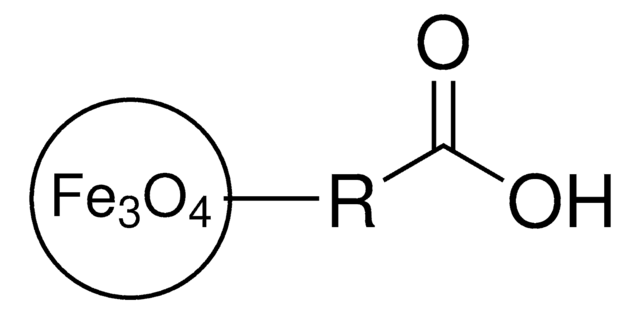700312
Eisenoxid(II,III), magnetische Nanopartikel -Lösung
10 nm avg. part. size, 5 mg/mL in toluene
Synonym(e):
Magnetische Eisenoxid Nanokristalle, Magnetit, Superparamagnetische Eisenoxid Nanopartikel
About This Item
Empfohlene Produkte
Form
nanoparticles
solution
Konzentration
5 mg/mL in toluene
Magnetisierung
>45 emu/g (at ambient temperature under 4500 Oe)
Durchschnittliche Teilgröße
10 nm
Partikelgröße
9-11 nm (TEM; conforms)
Dichte
0.865 g/mL at 25 °C
SMILES String
O=[Fe].O=[Fe]O[Fe]=O
InChI
1S/3Fe.4O
InChIKey
SZVJSHCCFOBDDC-UHFFFAOYSA-N
Suchen Sie nach ähnlichen Produkten? Aufrufen Leitfaden zum Produktvergleich
Allgemeine Beschreibung
It contains <1.0% oleic acid stabilizing ligands.
Anwendung
Signalwort
Danger
Gefahreneinstufungen
Aquatic Chronic 3 - Asp. Tox. 1 - Flam. Liq. 2 - Repr. 2 - Skin Irrit. 2 - STOT RE 2 - STOT SE 3
Zielorgane
Central nervous system
Lagerklassenschlüssel
3 - Flammable liquids
WGK
WGK 3
Flammpunkt (°F)
45.0 °F
Flammpunkt (°C)
7.2 °C
Persönliche Schutzausrüstung
Eyeshields, Faceshields, Gloves, type ABEK (EN14387) respirator filter
Analysenzertifikate (COA)
Suchen Sie nach Analysenzertifikate (COA), indem Sie die Lot-/Chargennummer des Produkts eingeben. Lot- und Chargennummern sind auf dem Produktetikett hinter den Wörtern ‘Lot’ oder ‘Batch’ (Lot oder Charge) zu finden.
Besitzen Sie dieses Produkt bereits?
In der Dokumentenbibliothek finden Sie die Dokumentation zu den Produkten, die Sie kürzlich erworben haben.
Kunden haben sich ebenfalls angesehen
Artikel
Currently, magnetic nanoparticles (MNPs) are attracting a lot of attention because of the possibility of many novel applications, especially in biomedical research.
A key challenge for nanomaterial safety assessment is the ability to handle the large number of newly engineered nanomaterials (ENMs), including developing cost-effective methods that can be used for hazard screening.
Graphene is a unique two-dimensional (2D) structure of monolayer carbon atoms packed into a dense honeycomb crystal that has attracted great interest due to its diverse and fascinating properties.
Professor Hui Mao explores the use of superparamagnetic iron oxide nanoparticles (INOPs) that offer an alternate contrast-enhancing mechanism.
Unser Team von Wissenschaftlern verfügt über Erfahrung in allen Forschungsbereichen einschließlich Life Science, Materialwissenschaften, chemischer Synthese, Chromatographie, Analytik und vielen mehr..
Setzen Sie sich mit dem technischen Dienst in Verbindung.





